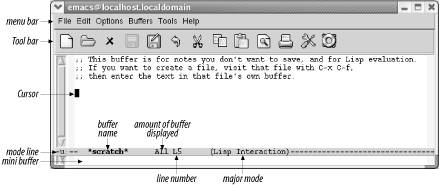
GNU Emacs is the most popular and widespread of the Emacs family of editors. It is also the most powerful and flexible. Unlike all other text editors, GNU Emacs is a complete working environment—you can stay within Emacs all day without leaving.
, 3rd Edition tells readers how to get started with the GNU Emacs editor. It is a thorough guide that will also "grow" with you: as you become more proficient, this book will help you learn how to use Emacs more effectively. It takes you from basic Emacs usage (simple text editing) to moderately complicated customization and programming.The third edition of
describes Emacs 21.3 from the ground up, including new user interface features such as an icon-based toolbar and an interactive interface to Emacs customization. A new chapter details how to install and run Emacs on Mac OS X, Windows, and Linux, including tips for using Emacs effectively on those platforms.
, third edition, covers:
Learning GNU Emacs
Learning GNU Emacs
Learning GNU Emacs
• How to edit files with Emacs
• Using the operating system shell through Emacs
• How to use multiple buffers, windows, and frames
• Customizing Emacs interactively and through startup files
• Writing macros to circumvent repetitious tasks
• Emacs as a programming environment for Java, C++, and Perl, among others
• Using Emacs as an integrated development environment (IDE)
• Integrating Emacs with CVS, Subversion and other change control systems for projects with multiple developers
• Writing HTML, XHTML, and XML with Emacs
• The basics of Emacs Lisp
The book is aimed at new Emacs users, whether or not they are programmers. Also useful for readers switching from other Emacs implementations to GNU Emacs.
1.5 About the Emacs Display
When you enter Emacs, you see a large workspace near the top of the window where you do your editing. (See Figure 1-1.)
Figure 1-1. Understanding the Emacs display
A cursor marks your position. The cursor is also called point, particularly among people who are more familiar with Emacs and in the online help system; therefore, it's useful to remember this term.
You don't have to do anything special before you start typing. As long as you type alphanumeric characters and punctuation, Emacs inserts them into your buffer. The cursor indicates where Emacs inserts the new characters; it moves as you type. Unlike many editors (particularly vi), Emacs does not have separate modes for inserting text and giving commands. Try typing something right now, and you'll begin to see how easy Emacs is to use. (If you get stuck for any reason, just press C-g.)





